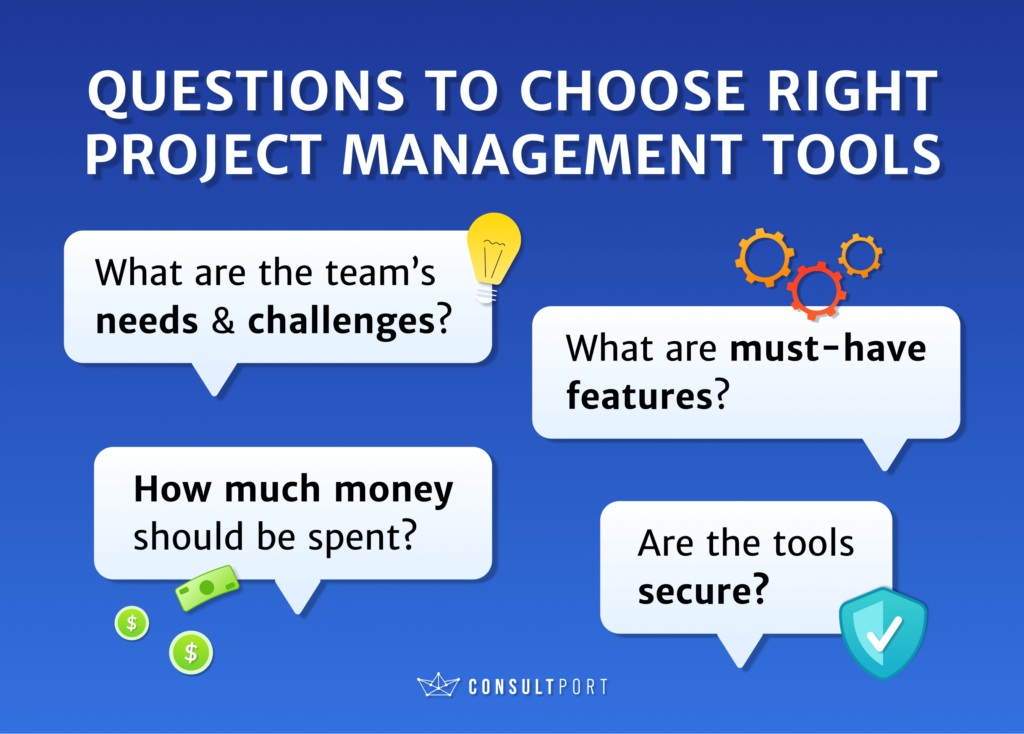Path to Success: How Project Management Tools Make a Difference?
Blog Categories:
Published:
February 1, 2024
Reading Time:
6 minutes

Firms invest a huge sum of money in projects with the hope to elevate their performance and expand the market. Some succeed, some don't.
Nearly $48 trillion are spent on projects every year, however, only 35% of projects are successful, according to the Harvard Business Review. The high rate of failure is attributed mainly to the “low level of maturity” of project management technologies, the magazine said.

In a fast-paced business environment, project managers need to adapt to continuous changes. They must go beyond the use of spreadsheets, and slides and shift to advanced project management tools to enhance team collaboration and increase productivity.
In this blog post, Consultport aims to give readers an overview of project management tools, its benefits and how AI will transform them in the future.
Nearly $48 trillion are spent on projects every year, however, only 35% of projects are successful, according to the Harvard Business Review. The high rate of failure is attributed mainly to the “low level of maturity” of project management technologies, the magazine said.

In a fast-paced business environment, project managers need to adapt to continuous changes. They must go beyond the use of spreadsheets, and slides and shift to advanced project management tools to enhance team collaboration and increase productivity.
In this blog post, Consultport aims to give readers an overview of project management tools, its benefits and how AI will transform them in the future.
KEY TAKEAWAYS
- Project management tools help to enhance collaboration, facilitate project planning and scheduling, enable risk identification and allow automated reports.
- By 2030, about 80% of tasks in project management will be done by AI. Project managers need to embrace changes and focus more on leadership, strategic thinking and business acumen.
- Advanced project management tools with more accurate predictions and testing systems will be widely available thanks to developed technologies.
Key Benefits of Using Project Management Tools
Project management software and tools are developed to help users plan their project, manage their resources, tackle problems and engage all stakeholders efficiently. Project management tools have remarkable impacts on the workflow and efficiency of a team.
Let’s delve deeper into the benefits and differences that these tools can bring to teams:
The tools also serve as a platform for teams to create detailed project objectives, tasks, plans and resources. Thanks to this platform, members are on the same page, avoiding miscommunication or misunderstandings. As a result, the enhanced collaboration leads to effective communication, improved working relationships and higher productivity.
These tools also give users access to real-time reports of progress. As a result, they can detect issues and make timely decisions.
An ideal tool or software must also allow users to switch between different methodologies and processes, whether it is agile, waterfall or hybrid.
With a clear understanding of the company or team’s needs, one can narrow down the options and focus on products that fit them.
For example, a tool with Gantt chart feature tells users the amount of time they should spend for a task and whether the time spent on a task may overlap with others. Meanwhile, the central dashboard feature helps users see all of their projects, ideas and progress.
Customization is also a useful feature that helps team members tailor their own task workflows and views. Another feature that users should look for in a project management tool is integration. This allows the integration of a main tool with another tool so users can share their projects with their clients.

It is also crucial to test some products or buy a small subscription to make sure that the tool works for the team and company.

The magazine noted that there are many aspects of project management that will be disrupted. Its forecast of key trends in project management include:
This means that it can assist selecting projects that are more likely to be successful and deliver higher benefits. It also helps prevent human bias in decision-making.
Technologies like big data and machine learning help to anticipate risks in a more sophisticated way. Project management tools will be able to suggest actions to mitigate risks and adjust the plan automatically to minimize risks.
Therefore, it can help businesses reduce time on testing activities and the number of rework.
Let’s delve deeper into the benefits and differences that these tools can bring to teams:
Enhanced collaboration
One of the biggest benefits of using project management tools is that it facilitates effective team collaboration. These tools allow members within a team and from different teams to exchange the information, discuss and collaborate in real time.The tools also serve as a platform for teams to create detailed project objectives, tasks, plans and resources. Thanks to this platform, members are on the same page, avoiding miscommunication or misunderstandings. As a result, the enhanced collaboration leads to effective communication, improved working relationships and higher productivity.
Better planning and scheduling
Project management tools are a comprehensive solution for firms to do the planning and scheduling. Team members and project managers can track and assign tasks, set deadlines, create timelines and update the progress.These tools also give users access to real-time reports of progress. As a result, they can detect issues and make timely decisions.
Risk identification
With detailed reports, analytics and insights, project management tools can help users detect potential risk and issues. Thus project managers can identify hidden trends or opportunities for improvements. They then develop a plan and take action to avoid the issues becoming a problem in the future.Better reporting
Project management tools enable customized and detailed reports to be generated automatically. Therefore, all team members can access updated project information and make changes if necessary.How to Choose Right Project Management Tools
According to Forbes, there are some key factors that firms should consider when choosing project management tools. They should consider the following questions before making the decision:- What are the team’s needs and challenges? Identifying the team’s needs and challenges is one of the most important steps in choosing a project management tool.
An ideal tool or software must also allow users to switch between different methodologies and processes, whether it is agile, waterfall or hybrid.
With a clear understanding of the company or team’s needs, one can narrow down the options and focus on products that fit them.
- What are must-have features? Functionality of a tool is an important factor to consider. A survey of project management software users in the US reports that 36 percent of the respondents viewed the software’s functionality as a significant factor in their decision to purchase the tool.
For example, a tool with Gantt chart feature tells users the amount of time they should spend for a task and whether the time spent on a task may overlap with others. Meanwhile, the central dashboard feature helps users see all of their projects, ideas and progress.
Customization is also a useful feature that helps team members tailor their own task workflows and views. Another feature that users should look for in a project management tool is integration. This allows the integration of a main tool with another tool so users can share their projects with their clients.

It is also crucial to test some products or buy a small subscription to make sure that the tool works for the team and company.
- How much money should be spent? Depending on the budget, the company can decide which project management tools suit them the most. It should consider the long-term value of the tool or software and how the use of it will contribute to the achievement of goals.
- Are the tools secure? Security is a crucial factor to consider. Companies should use tools that have strong security features including encryption, two-factor authentication and role-based access controls.
Key Trends in Project Management Tools
Research by Gartner predicts that in the next six years, about 80% of tasks in project management will be done by AI, which is powered by “big data, machine learning (ML), and natural language processing”, according to the Harvard Business Review.
The magazine noted that there are many aspects of project management that will be disrupted. Its forecast of key trends in project management include:
Improved prediction with higher accuracy level
When more accurate data is available, machine learning can identify patterns and generate more accurate predictions than humans.This means that it can assist selecting projects that are more likely to be successful and deliver higher benefits. It also helps prevent human bias in decision-making.
Better risk management and project planning
According to the Harvard Business Review, risk management is among the most advanced aspects of project management automation.Technologies like big data and machine learning help to anticipate risks in a more sophisticated way. Project management tools will be able to suggest actions to mitigate risks and adjust the plan automatically to minimize risks.
Advanced testing system
It is predicted that advanced testing systems, which are now only feasible for certain megaprojects, will be more widely available. They will enable users to detect defects early and facilitate self-correcting processes.Therefore, it can help businesses reduce time on testing activities and the number of rework.
New role for project managers
It may sound daunting for many project managers when many parts of their tasks will be automated. However, competent managers will embrace and take advantage of the changes. The Harvard Business Review magazine suggests that project managers must shift away from administrative work and focus more on leadership, strategic thinking, and business acumen.Conclusion
Project management tools have significant values in improving collaboration, enhancing productivity, and keeping teams on track. In a continuously changing business environment, firms have become increasingly aware of the importance of using advanced tools and software in managing their projects.
It is predicted that by 2030, the project management software market is expected to reach a valuation of $15.08 billion, representing a compound annual growth rate of 10.68% from 2022 to 2030.

At Consultport, our talented consultants have helped firms implement advanced project management tools to elevate their performance to new heights. If you aspire to be part of our dynamic team and join exciting projects with leading organizations all over the world, don’t hesitate to contact us.
It is predicted that by 2030, the project management software market is expected to reach a valuation of $15.08 billion, representing a compound annual growth rate of 10.68% from 2022 to 2030.

At Consultport, our talented consultants have helped firms implement advanced project management tools to elevate their performance to new heights. If you aspire to be part of our dynamic team and join exciting projects with leading organizations all over the world, don’t hesitate to contact us.
Share This Story, Choose Your Platform!



